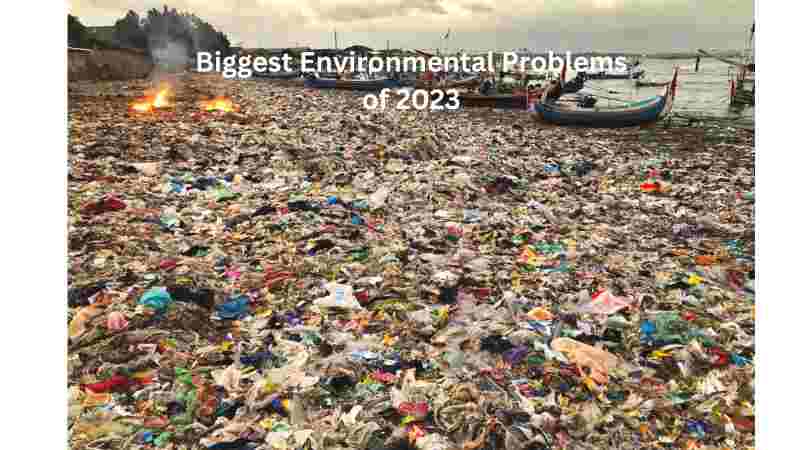As we delve into the 15 biggest environmental problems of 2023 including pollution, it becomes evident that these challenges are interconnected, weaving a complex tapestry that requires a comprehensive and coordinated response.
Contents
- 1 1. Global Warming From Fossil Fuels
- 2 2. Poor Governance
- 3 3. Food Waste
- 4 4. Biodiversity Loss
- 5 5. Plastic pollution
- 6 6. Deforestation & pollution
- 7 7. Air pollution
- 8 8. Melting Ice Caps and the Looming Tide of Sea Level Rise
- 9 9. Ocean Acidification
- 10 10. Agriculture
- 11 11. Food and Water Insecurity
- 12 12. Fast Fashion and Textile Waste
- 13 13. Overfishing
- 14 14. Cobalt Mining Causes pollution
- 15 15. Soil Degradation
- 16 Conclusion
1. Global Warming From Fossil Fuels
Unprecedented CO2 Levels and Rising Global Temperatures
As of May 2023, the Earth faces a critical environmental challenge marked by a CO2 concentration of 420.00 PPM and a global temperature rise of 1.15°C since pre-industrial levels. Greenhouse gas emissions from fossil fuels have triggered alarming consequences, including devastating bushfires, locust swarms, and unprecedented heatwaves.
Urgent Need for Action
Despite warnings from scientists about impending tipping points, governments worldwide are struggling to address the climate crisis effectively. Immediate measures, including reducing greenhouse gas emissions, investing in renewable energy, and phasing out fossil fuels, are imperative.
ALSO VISIT: Tragedy Strikes Maine: The Hunt for the Suspect in the Worst Mass Killing in State History
2. Poor Governance
Addressing Market Failures in Climate Crisis Management
Renowned economists like Nicholas Stern emphasize the role of market failures in exacerbating the climate crisis. Policymakers are urged to implement effective measures, such as carbon taxes, to stimulate low-carbon innovations. However, current tax structures globally lack alignment with energy source pollution profiles, highlighting the need for comprehensive policy reforms.
UN’s Inadequacy and Equity Concerns
Criticism is also directed towards international bodies like the United Nations, deemed unfit to handle the climate crisis. The voluntary nature of agreements, such as the Paris Agreement, raises concerns about compliance, especially with developing countries granted leniency in emissions. This creates an exploitative scenario, notably exemplified by countries like China.
3. Food Waste
A Third of Global Food Wasted: A Critical Environmental Issue
Approximately 1.3 billion tons of food intended for human consumption, equivalent to a third of global production, goes to waste annually. This not only perpetuates food insecurity but also contributes significantly to greenhouse gas emissions, positioning food waste as the third-highest emitter globally.
Aesthetic Wastage and Insecurity
The shocking reality of over 50% of discarded produce in the U.S. being deemed “too ugly” underscores the superficial reasons for waste. Beyond environmental concerns, food waste intensifies global food insecurity, demanding urgent attention.
4. Biodiversity Loss
Human Consumption’s Toll on Earth’s Species
Human activities, driven by population growth and urbanization, have led to a staggering 68% decline in the population sizes of various species from 1970 to 2016. Land-use changes, particularly the conversion of habitats into agricultural systems, exacerbate biodiversity loss, with illegal wildlife trade further threatening species like pangolins.
Accelerating Sixth Mass Extinction
The acceleration of the sixth mass extinction is alarming, with over 500 land animal species on the brink of extinction within two decades. Urgent conservation efforts are required to mitigate the irreversible loss of Earth’s biodiversity.
5. Plastic pollution
Escalating Production and the Unchecked Proliferation of Plastic
Since 1950, annual plastic production has skyrocketed from 2 million to 419 million tons by 2015, resulting in approximately 14 million tons entering the oceans annually. Shockingly, 91% of all plastic ever produced remains unrecycled, highlighting a colossal environmental failure.
Long-term Consequences
With plastic taking 400 years to decompose, the long-term consequences of unchecked plastic pollution on ecosystems and human health are unpredictable, necessitating immediate global action.
6. Deforestation & pollution
The Relentless Stripping of Earth’s Lungs
Every hour witnesses deforestation equivalent to 300 football fields. If unabated, projections suggest a mere 10% of global forests by 2030. Brazil, the Democratic Republic of Congo, and Indonesia are at the forefront of legal deforestation, with the Amazon rainforest, a biodiversity hotspot, facing severe threats.
Agricultural Expansion’s Impact
Driven primarily by agriculture, the leading cause of deforestation, urgent measures are required to preserve forests, essential for carbon sequestration and preventing soil erosion.
7. Air pollution
Outdoor Air Pollution’s Devastating Impact on Global Health
Outdoor air pollution claims an estimated 4.2 to 7 million lives annually worldwide. Industrial sources, motor vehicles, biomass burning, and dust storms contribute to poor air quality, with Europe experiencing 400,000 annual deaths due to air pollution.
Link to COVID-19
In the context of the COVID-19 pandemic, the correlation between air pollution and virus transmission raises critical concerns, demanding comprehensive studies to understand the dynamics.
8. Melting Ice Caps and the Looming Tide of Sea Level Rise
Accelerating Loss of Polar Ice and Impending Sea Level Rise
The Arctic, warming at twice the global rate, faces unprecedented ice loss, with Greenland losing a record 60 billion tons in just two months. Melting ice caps, especially in Greenland and Antarctica, contribute significantly to rising sea levels, threatening coastal regions and major cities.
Dire Predictions
Projections suggest sea level rise could displace millions, emphasizing the urgency of addressing climate change to mitigate these catastrophic consequences.
9. Ocean Acidification
CO2 Absorption and its Devastating Impact on Marine Life
Rising global temperatures contribute to ocean acidification, with oceans absorbing 30% of released carbon dioxide. This phenomenon poses severe threats to marine ecosystems, food webs, and coral reefs, accelerating the loss of biodiversity.
Link to Plastic Pollution
Studies suggest a potential connection between ocean acidification and plastic pollution, underscoring the interconnected nature of environmental challenges.
10. Agriculture
Agriculture’s Significant Contribution to Greenhouse Gas Emissions
The global food system is responsible for a third of human-caused greenhouse gas emissions, with livestock and fisheries accounting for 30%. Large-scale cattle ranching, a major contributor, consumes vast amounts of land and freshwater, further straining environmental resources.
Call for Plant-Based Diets
Scientists advocate for a shift towards plant-based diets to reduce the environmental impact of conventional agriculture and mitigate the strain on land and water resources.
11. Food and Water Insecurity
Escalating Threats to Global Food and Water Resources
Unsustainable farming practices and rising temperatures contribute to soil erosion, threatening global food security. With over 820 million people experiencing food insecurity and projections of water shortages for two-thirds of the global population by 2025, immediate action is crucial.
Urgent Call for Sustainable Practices
UN Secretary-General António Guterres highlights the impending global food security emergency, urging countries to adopt sustainable farming practices and rethink their food systems.
12. Fast Fashion and Textile Waste
Fashion Industry’s Environmental Toll
The fashion industry, responsible for 10% of global carbon emissions, generates massive textile waste. With an estimated 92 million tonnes discarded annually, the industry’s reliance on fast fashion exacerbates environmental challenges, including pollution and resource depletion.
Need for Industry Accountability
Despite initiatives like the UN Fashion Industry Charter for Climate Action, the majority of fashion businesses continue to contribute significantly to climate change and environmental degradation.
13. Overfishing
Depleting Fish Stocks and Environmental Consequences
Overfishing poses a severe threat to marine ecosystems, with 30% of commercially fished waters classified as overfished. The practice results in increased algae, destruction of fishing communities, ocean littering, and significant biodiversity loss.
WTO’s Historic Deal
The World Trade Organization’s ban on fishing subsidies aims to address global overfishing, highlighting the need for stricter regulations and sustainable fishing practices.
14. Cobalt Mining Causes pollution
Renewable Energy’s Conundrum: The Dark Side of Cobalt Mining
As a crucial component in electric vehicle batteries, cobalt mining faces a surge in demand. However, this comes with severe environmental and social consequences, including dangerous exploitation of workers, high radioactivity levels, and pollution of water sources.
Balancing Renewable Transition
Efforts towards decarbonization need to address the ethical and environmental issues associated with cobalt mining, emphasizing the need for responsible sourcing and production.
15. Soil Degradation
Diminishing Soil Health and Implications for Food Security
About 40% of the planet’s soil is degraded, primarily due to human activities such as traditional farming practices and the use of toxic chemicals. Soil degradation not only impacts fertility but also jeopardizes global food security.
Urgent Need for Sustainable Practices
A shift towards sustainable agricultural practices is crucial to prevent further soil degradation and ensure long-term food security for the growing global population. Immediate action is needed to reverse current trends and preserve soil health.
READ MORE
Conclusion
In conclusion, the 15 environmental problems highlighted are interconnected and urgent. Addressing these challenges requires collective efforts from individuals, industries, and governments globally. A paradigm shift towards sustainability, coupled with innovative technologies and stringent regulations, is imperative to ensure a habitable and thriving planet for current and future generations. The time to act is now, as the consequences of inaction are too severe to ignore.



